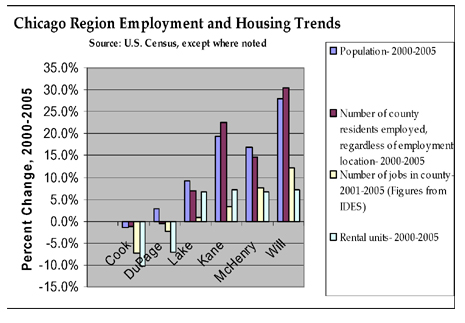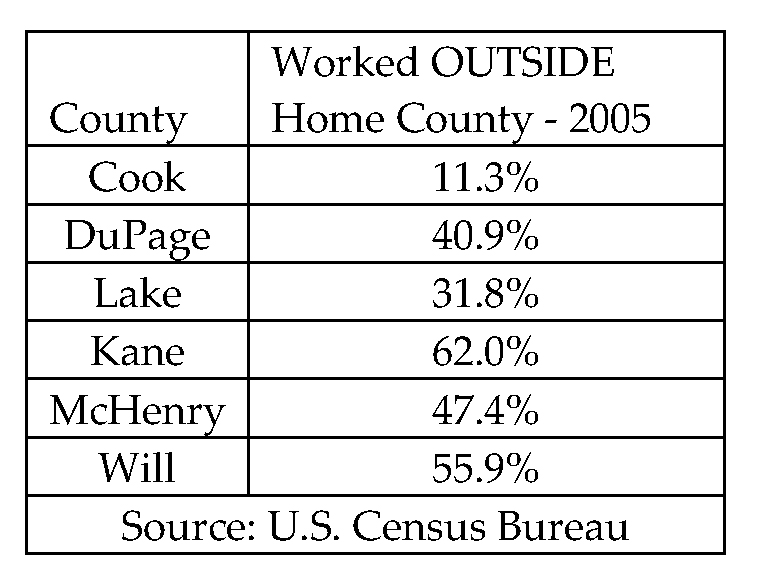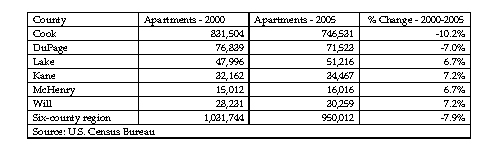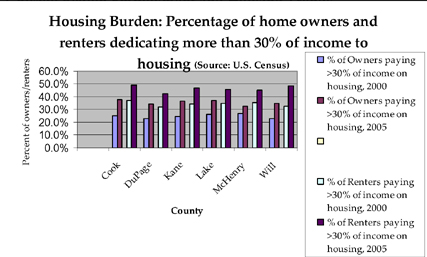The challenges and opportunities for affordable housing in northeastern Illinois.
Do you know someone who teaches preschool, assists a doctor, or manages a database? Did you know they are among the growing number of working people unable to afford a home in the six-county Chicago region? Home-ownership is almost entirely out of the question, and renting is getting harder. Rents are rising (and at a rate much higher than wages), while the number of apartments is dropping.

Many regional workers are forced to move further away from job centers in order to afford a home and then suffer longer commutes, more traffic, and a shortage of mass transit options.
Challenges
Between 2000 and 2005, the six-county region grew 3.4 percent (despite Cook County’s loss of over 73,000 people). Notable growth occurred in Will (28%), Kane (19.2%), and McHenry (16.8 %) counties. However, according to the Ill. Dept. of Employment Security, the number of jobs in Cook and DuPage Counties fell between 2001 and 2005. The number of jobs in some counties rose, but jobs are not being created in Will, McHenry, Kane, or Lake counties at a rate proportional to population growth. In addition, the number of apartments in the region fell between 2000 and 2005. As more people move into the outlying counties of the six-county region, rental opportunities, like job opportunities, are slow to follow. 
Key sectors of the workforce and our communities are being priced out, according to data from the Chicago Tribune, Hendricks and Partners, and Illinois Workforce Information Center.

Across the six-county region, essential workers such as preschool teachers, fire fighters, medical assistants, and many others cannot afford to buy or rent homes.

Housing cost burden is on the rise throughout the region. In 2000, 21 percent of home owners in the state and 24.7 percent in the region were dedicating more than 30 percent of their incomes to housing needs. As of 2005, this percentage had risen to 38 percent in Illinois and 36.8 regionally.

Renters felt a similar crunch; in 2000, 35.3 percent of renters in Illinois and 36.4 percent regionally dedicated more than 30 percent of income to rent; by 2005, this had increased to 46.1 percent in Illinois and 48.5 percent in the region. In 2005, nearly half of all renters in the state and the region were using more than 30 percent of income (the standard measure of affordability) on housing. Of even greater concern, this surge of approximately 10 percentage points was observed in every county in the region.
True measures of affordability must incorporate transportation costs. According to a recent study from the Center for Neighborhood Technology, the median U.S. household spends 18 percent of income on transportation, and those with lower income spend a higher percentage of income on transportation than do higher income households. For U.S. families earning between $20,000 and $30,000 annually, the total cost of housing and transportation exceeds 60 percent of income. This is money that could be invested, saved or pumped into the local economy.
Opportunities
The Housing Endorsement Criteria and Housing Action Agenda of the Metropolitan Mayors Caucus (MMC) continue to shape regional housing policy, and have been influential at the state level as well. The Criteria spell out how housing for a growing workforce — housing affordable to local workers at a broad range of incomes that is well managed, well designed, and located near jobs and transit — can be a community asset. The Housing Action Agenda outlines a number of steps that must be taken to preserve, expand and encourage an increase in quality housing options. MMC’s Housing Committee continues to provide an effective forum, including an increasing arsenal of tools for shared learning and constructive dialogue about key housing issues for municipal leaders.
In January of 2005, the State of Illinois released "Building for Success: Illinois' Comprehensive Housing Plan," the first housing plan of its kind for the state. It was based on Gov. Rod Blagojevich's 2003 Executive Order , which outlined the state’s housing policy and priorities. He also appointed a Task Force to transform these policies into a multi-year plan to promote affordability and choice, create and preserve the state's supply of affordable and workforce housing, and engage local and state leaders in advancing housing solutions for all Illinois families.
The state released an update to plan in 2006: "On the Road to Success: Illinois' Comprehensive Housing Plan 2006," which was later strengthened when the Ill. General Assembly turned the governor’s Executive Order into legislation. Senate Bill 2290, the Comprehensive Housing Planning Act, created permanent measures to create and preserve affordable housing across the state by better coordinating state agencies such as the Illinois Housing Development Authority (IHDA) and the Departments of Commerce and Economic Opportunity, Human Services, Aging, Veterans' Affairs, and Healthcare and Family Services.
Building on legislation passed in 2005, merging the land-use powers of the Northeastern Illinois Planning Commission (NIPC) and Chicago Area Transportation Study (CATS), to create the Chicago Metropolitan Agency for Planning (CMAP), has presented an unprecedented opportunity to improve the state of affordable housing close to job centers in northeastern Illinois. CMAP is charged with ‘maximizing our limited resources and improving coordination on both transportation and land use needs for the entire region.' As CMAP’s responsibilities and capabilities are defined, it is immensely important to improve the affordability of housing. CMAP can do this by advocating for increased state funding for planning and then administering these dollars to communities stressing housing affordability, education on best practices and current trends, and innovative policies that expand housing opportunities close to jobs.
Also passed in 2006 was Senate Bill 2885, the Location Efficiency Incentive Act, which provides incentives to business locating close to affordable housing and access to public transportation. A similar measure, “Good Housing Good Schools,” would, if passed, provide a funding bonus to school districts in which affordable housing is constructed or preserved.
In 2005, the Illinois General Assembly approved a bill that continues the Illinois Affordable Housing Tax Credit program through 2011. State tax credits provide a $.50 credit for each $1 an employer invests in an employer-assisted housing (EAH) program, and are available to employers that help their employees with down-payment assistance, rental assistance, Individual Development Accounts (homeownership savings programs), reduced interest mortgages, and mortgage guarantees.
EAH initiatives in Illinois have made great strides, supporting bottom-line savings for employers investing in workforce housing, but also improving employees’ lives and opening doors to housing solutions. Over the course of 2006, close to 400 employees bought homes with assistance from their employers, bringing the total to nearly 1,000 since MPC launched the EAH model in 2000. The annual total of successful buyers has consistently increased every year since the beginning of the program, with a 25 percent increase in closings from 2005-2006. Overall, more than 2000 employees have benefited from EAH since 2000, including those receiving credit counseling, homeownership education, and down payment assistance. 65 employers have “signed on” to EAH, over that same time period, and the numbers continue to increase.
The greater importance of these tools is that they embolden business, school, and other non-government entities to lead the way in creating and preserving housing that is affordable to the local workforce, including teachers and nurses and other essential members of our communities. These government programs and EAH are opportunities for expanding the amount of sorely needed affordable workforce housing available in the six-county region. The shortage of affordable housing near job centers results in the loss of open space, increased number of long-distance commuters, continued dependence on fossil fuels, and strains hard-working individuals and their families. Whether one’s primary concern is health care or education, gridlock or water supply, community revitalization or workforce competitiveness, Illinois’ ability to tackle these issues depends on the availability of a range of quality housing options near jobs and transit throughout the state.
Resources
· The Metropolitan Mayors Caucus' Housing Endorsement Criteria and Housing Action Agenda: The Endorsement Criteria identify housing that is well-designed, well-maintained, near jobs and transit and available to people with a range of incomes as the type of housing that Mayors value. The Action Agenda is a roadmap for expanding affordable housing opportunities.
· Sensible Tools for Healthy Communities and Planning 1-2-3 : Created by the Metropolitan Mayors Caucus, Campaign for Sensible Growth and Metropolitan Planning Council (MPC), these workbooks address planning and development from a municipal standpoint. The Sensible Tools workbook is a tool for elected and appointed officials to use when making development decisions. Planning 1 -2- 3 discusses developing or updating comprehensive plans in Illinois . It guides readers through issues of housing, economic development, transportation and protection of natural resources.
· Welcome Home: Housing Our Community : This video features Mayors, developers, residents, and employers discussing local solutions to a growing shortage of homes affordable to working families in the region and across Illinois . Welcome Home can be used as a meeting starter, whenever a housing policy or development is being considered, to frame discussions of workforce housing in a positive light.
· Homes for a Changing Region : Produced in collaboration with Chicago Metropolis 2020, this report details the demographic changes expected in the region between 2000 and 2030, and examines how these will impact housing demand across the metropolitan Chicago area. The partners are currently conducting a similar assessment for each community in the Chicago region.
· Guidelines for a Model Housing Plan: In 2003, the state passed the Affordable Housing Planning and Appeal Act, which required that all municipalities that do not have at least ten percent of their housing stock designated as affordable draft an affordable housing plan. The Caucus put together an ad-hoc committee to produce guidelines for a model affordable housing plan. This document can be used by any community looking to address housing issues, not just those found to be under the 10% state limit.
· Home Grown: Local Housing Strategies in Action . A collection of housing-related Best Practices from the Chicago region, Home Grown was created in partnership with Chicago Metropolis 2020, MMC and MPC. Home Grown shows municipal officials how their peers are addressing housing issues and provides ideas for replicating or improving upon these approaches to address their own local housing challenges. Each best practices summary focuses on how a program, policy or development came about, how it works, why it has been successful, and how it is financed.
· Regional Employer-Assisted Collaboration for Housing (REACH). Employer-assisted housing (EAH) is a cost effective, easy to administer, hassle free way for employers to help their employees buy or rent homes close to work. In Illinois, MPC, Housing Action Illinois, and more than a dozen REACH partners make it easy and financially compelling for employers to offer EAH programs to their employees. Through REACH Illinois, more than 400 employees have bought homes since 2000, and only five have left their jobs.
· Regional Housing Initiative (RHI). RHI provides financial incentives (via operating subsidies) to developers and owners of quality rental housing addressing two pressing issues affecting northeastern Illinois that resurfaced in recent census findings and reports. Those issues, also priority concerns of Gov. Rod Blagojevich , are: (1) the shortage of quality, mixed-income rental housing located near jobs and transit, and (2) the scarcity of housing affordable to households earning less than fifty percent of the area's median income (AMI). Also, RHI can help implement the sort of housing solutions prioritized in Building for Success: Illinois' Comprehensive Housing Plan, released by the Office of Gov. Rod Blagojevich on January 24, 2005.
· Community Acceptance Strategy. MPC, MMC, Housing Illinois (HI) and the Illinois Housing Council (IHC) have developed a Community Acceptance Strategy to build public and political acceptance for quality workforce and affordable housing developments and policies throughout the region. This strategy, which utilizes the mayors' Housing Endorsement Criteria, is designed to help developers and mayors gain support for housing development and policy proposals in communities that historically have not generated or encouraged housing that meets the needs of the local workforce and other low to moderate income households.
· Community Building Initiative. MPC’s Community Building Initiative provides technical assistance to provide solutions to development challenges faced by communities; test and refine policies and strategies; provide models for other communities; and create a network of regional partners and contacts.
For more information, contact Robin Snyderman, MPC housing director, at 312.863.6007 or rsnyderman@metroplanning.org ; or Beth Dever, housing director, Metropolitan Mayors Caucus, at 312.201.4507 or beth.dever@mayorscaucus.org .
Online Resources:
www.reachillinois.org
Community Acceptance Strategy
Home Grown: www.metroplanning.org/homegrown/
www.mayorscaucus.org
www.chicagometropolis2020.org
www.housingillinois.org
www.ilhousing.org